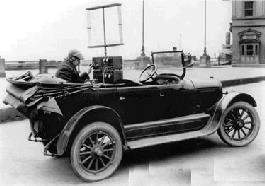
- UMTS Tutorial
- UMTS - Home
- History of Mobile Communication
- Cellular Concepts
- Cellular Concepts - Introduction
- GSM Architecture
- Cellular Concepts - GSM Radio Link
- Cellular Concepts - Mobility
- Cellular Concepts - GPRS
- Cellular Concepts - EDGE
- UMTS Introduction
- UMTS - A New Network
- UMTS - WCDMA Technology
- UMTS - HSPA Standardization
- UMTS - Objectives
- UMTS - Authentication
- UMTS - Success and Limitations
- UMTS Networks Standardization
- UMTS - 3GPP
- UMTS - Radio Access Network
- UMTS - Evolved Packet Core
- UMTS Protocol Environment
- UMTS - GPRS Tunneling Protocol
- UMTS - Proxy Mobile IPv6
- UMTS - EAP
- UMTS - IKEv2 & MOBIKE
- UMTS - SCTP
- UMTS - NAS Signaling Protocol
- UMTS Useful Resources
- UMTS - Quick Guide
- UMTS - Useful Resources
- UMTS - Discussion
History of Mobile Communication
Wireless communication was a magic to our ancestors but Marconi could initiate it with his wireless telegraph in 1895. Wireless Communication can be classified into three eras.
- Pioneer Era (Till 1920)
- Pre Cellular Era(1920-1979)
- Cellular Era (beyond 1979)
The first commercial mobile telephone system was launched by BELL in St. Louis, USA, in 1946. Few lucky customers got the services. Early mobile systems used single high power transmitters with analog Frequency Modulation techniques to give coverage up to about 50 miles and hence only limited customers could get the service due to this severe constraints of bandwidth.

Cellular Era
To overcome the constraints of bandwidth scarcity and to give coverage to larger sections, BELL lab introduced the principle of Cellular concept. By frequency reuse technique this method delivered better coverage, better utility of available frequency spectrum and reduced transmitter power. But the established calls are to be handed over between base stations while the phones are on move.
Even though the US based BELL lab introduced the cellular principle, the Nordic countries were the first to introduce cellular services for commercial use with the introduction of the Nordic Mobile Telephone (NMT) in 1981.
First Generation Systems
All these systems were analog systems, using FDMA technology. They are also known as First Generation (1G) systems. Different systems came into use based on the cellular principle. They are listed below.
| Year | Mobile System |
|---|---|
| 1981 | Nordic Mobile Telephone(NMT)450 |
| 1982 | American Mobile Phone System(AMPS) |
| 1985 | Total Access Communication System(TACS) |
| 1986 | Nordic Mobile Telephony(NMT)900 |
Disadvantages of 1G systems
- They were analog and hence are were not robust to interference.
- Different countries followed their own standards, which were incompatible.
To overcome the difficulties of 1G, digital technology was chosen by most of the countries and a new era, called 2G, started.
Advantages of 2G
- Improved Spectral Utilization achieved by using advanced modulation techniques.
- Lower bit rate voice coding enabled more users getting the services simultaneously.
- Reduction of overhead in signaling paved way for capacity enhancement.
- Good source and channel coding techniques make the signal more robust to Interference.
- New services like SMS were included.
- Improved efficiency of access and hand-off control were achieved.
| Name of the Systems | Country |
|---|---|
| DAMPS-Digital Advanced Mobile Phone System | North America |
| GSM-Global System for Mobile communication | European Countries and International applications |
| JDC - Japanese Digital Cellular | Japan |
| CT-2 Cordless Telephone–2 | UK |
| DECT-Digital European Cordless Telephone | European countries |
History of GSM
GSM standard is a European standard, which has addressed many problems related to compatibility, especially with the development of digital radio technology.
Milestones of GSM
- 1982 - Confederation of European Post and Telegraph (CEPT) establishes Group Special Mobile.
- 1985 - Adoption of list of recommendation was decided to be generated by the group.
- 1986 - Different field tests were done for radio technique for the common air interface.
- 1987 - TDMA was chosen as the Access Standard. MoU was signed between 12 operators.
- 1988 - Validation of system was done.
- 1989 - Responsibility was taken up by European Telecommunication Standards Institute (ETSI).
- 1990 - First GSM specification was released.
- 1991 - First commercial GSM system was launched.
Frequency Range of GSM
GSM works on four different frequency ranges with FDMA-TDMA and FDD. They are as follows −
| System | P-GSM (Primary) | E-GSM (Extended) | GSM 1800 | GSM 1900 |
|---|---|---|---|---|
| Freq Uplink | 890-915MHz | 880-915MHz | 1710-1785Mhz | 1850-1910MHz |
| Freq Downlink | 935-960MHz | 925-960MHz | 1805-1880Mhz | 1930-1990MHz |